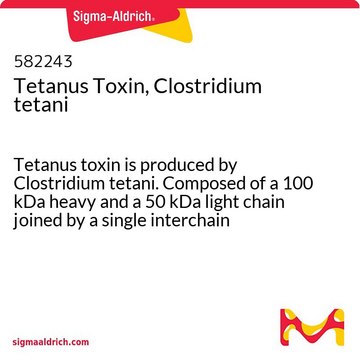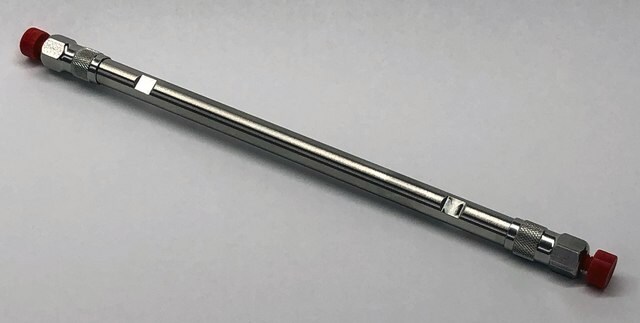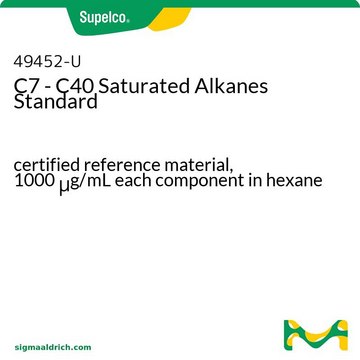SML1153
Clostridium difficile Toxin B
≥95% (SDS-PAGE), lyophilized powder, cellular toxin
Synonym(s):
C. difficile Toxin B, Clostridium Toxin B
Sign Into View Organizational & Contract Pricing
All Photos(1)
About This Item
Recommended Products
Product Name
Clostridium difficile Toxin B, ≥95% (SDS-PAGE)
Quality Level
Assay
≥95% (SDS-PAGE)
form
lyophilized powder
storage temp.
2-8°C
Looking for similar products? Visit Product Comparison Guide
General description
Native toxin B purified from C. difficile strain VPI10463 (toxinotype 0)
Biochem/physiol Actions
Clostridium difficile Toxin A and B, cation-dependent UDP-glucose glucosyltransferases, are cellular toxins that inactivate Rho (and Rho family small GTPases) through monoglucosylation of these family members. Effects of this monoglucosylation include disregulation of the actin cytoskeleton, cell rounding, cytotoxicity, and altered cellular signaling. Rho proteins are monoglucosylated by Toxin A and B using UDP-glucose as a cosubstrate. Rho, Rac and Cdc42 are included in the Rho subfamilies targeted by both toxins. Low molecular mass GTP-binding proteins that are not modified by Toxin A and B include Ras, Rab, Arf, or Ran subfamilies as well as heterotrimeric G proteins.
Inactivates Rho (and Rho family small GTPases). Causes disregulation of the actin cytoskeleton, cell rounding, cytotoxicity, and altered cellular signaling.
Clostridium difficile is a bacteria that causes antibiotic-associated pseudomembranous colitis. This bacterium produces two high molecular weight exotoxins, toxin A and B. Toxin B is more effective than toxin A in disrupting human colonic epithelium in vitro.
Clostridium difficile is a bacteria that causes antibiotic-associated pseudomembranous colitis. This bacterium produces two high molecular weight exotoxins, toxin A and B. Toxin B is more effective than toxin A in disrupting human colonic epithelium in vitro.
Toxin B is 100-1,000-fold more cytotoxic than toxin A in inducing rounding-up of cells and destruction of the actin cytoskeleton.
Features and Benefits
This compound is a featured product for Cyclic Nucleotide research. Click here to discover more featured Cyclic Nucleotide products. Learn more about bioactive small molecules for other areas of research at sigma.com/discover-bsm.
This compound is featured on the GTP Binding Proteins (Low Molecular Weight) page of the Handbook of Receptor Classification and Signal Transduction. To browse other handbook pages, click here.
Reconstitution
Contents of the 50 μg SKU when reconstituted in 250 μL sterile distilled water will contain Toxin B at a concentration of approximately 0.2 mg/mL in 0.05 M Hepes, 0.15 M sodium chloride and 5% sucrose.
Contents of the 2 μg SKU when reconstituted in 100 μL sterile distilled water will contain Toxin B at a concentration of approximately 0.02 mg/mL in 0.05 M Hepes, 0.15 M sodium chloride and 5% sucrose.
Contents of the 2 μg SKU when reconstituted in 100 μL sterile distilled water will contain Toxin B at a concentration of approximately 0.02 mg/mL in 0.05 M Hepes, 0.15 M sodium chloride and 5% sucrose.
Other Notes
After reconstitution, the reconstituted liquid can be frozen at -80 °C to -20 °C to extend stability to 1 year; however every freeze/thaw cycle wil cause increased aggregation. Avoid multiple freeze/thaw cycles and multiple temperature fluctuations.
Mixing: Swirl or pipette gently to mix. Vortexing may promote aggregation.
Mixing: Swirl or pipette gently to mix. Vortexing may promote aggregation.
Signal Word
Danger
Hazard Statements
Precautionary Statements
Hazard Classifications
Acute Tox. 3 Oral - Acute Tox. 4 Dermal - Acute Tox. 4 Inhalation
Storage Class Code
6.1A - Combustible acute toxic Cat. 1 and 2 / very toxic hazardous materials
WGK
WGK 2
Choose from one of the most recent versions:
Already Own This Product?
Find documentation for the products that you have recently purchased in the Document Library.
Nucleotide sequence of Clostridium difficile toxin B gene.
Barroso L A, et al.
Nucleic Acids Research, 18(13), 4004-4004 (1990)
Clostridium difficile toxin B is more potent than toxin A in damaging human colonic epithelium in vitro.
Riegler M, et al.
The Journal of Clinical Investigation, 95(5), 2004-2011 (1995)
Glucosylation of Rho proteins by Clostridium difficile toxin B.
Just I, et al.
Nature, 375(6531), 500-500 (1995)
Our team of scientists has experience in all areas of research including Life Science, Material Science, Chemical Synthesis, Chromatography, Analytical and many others.
Contact Technical Service








